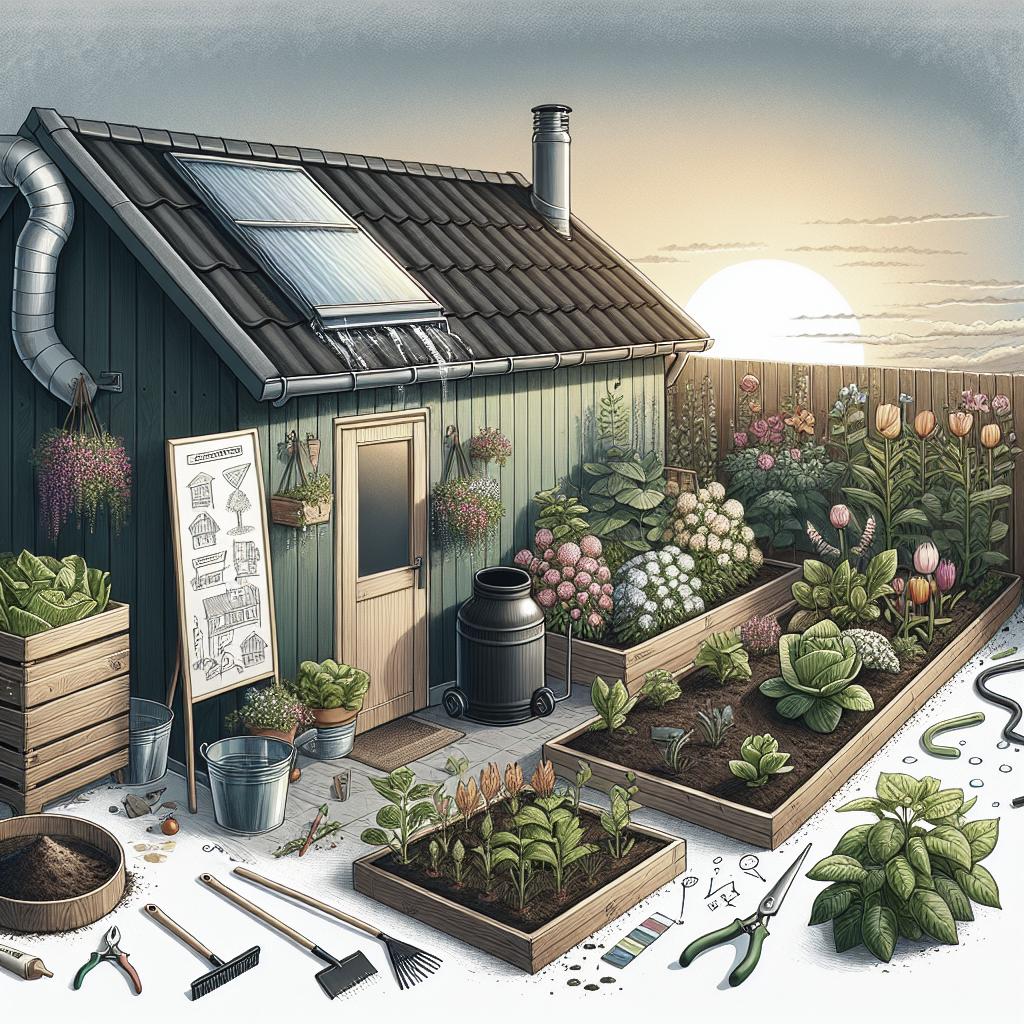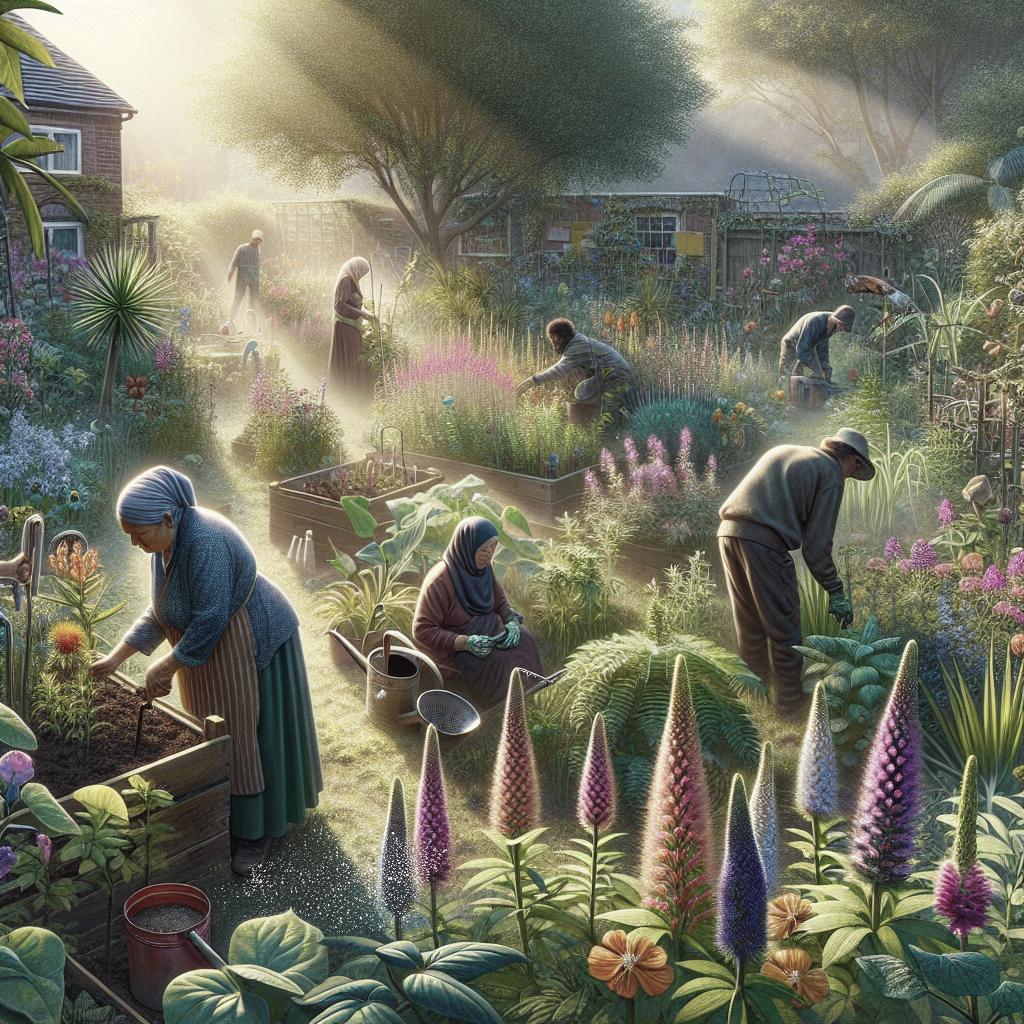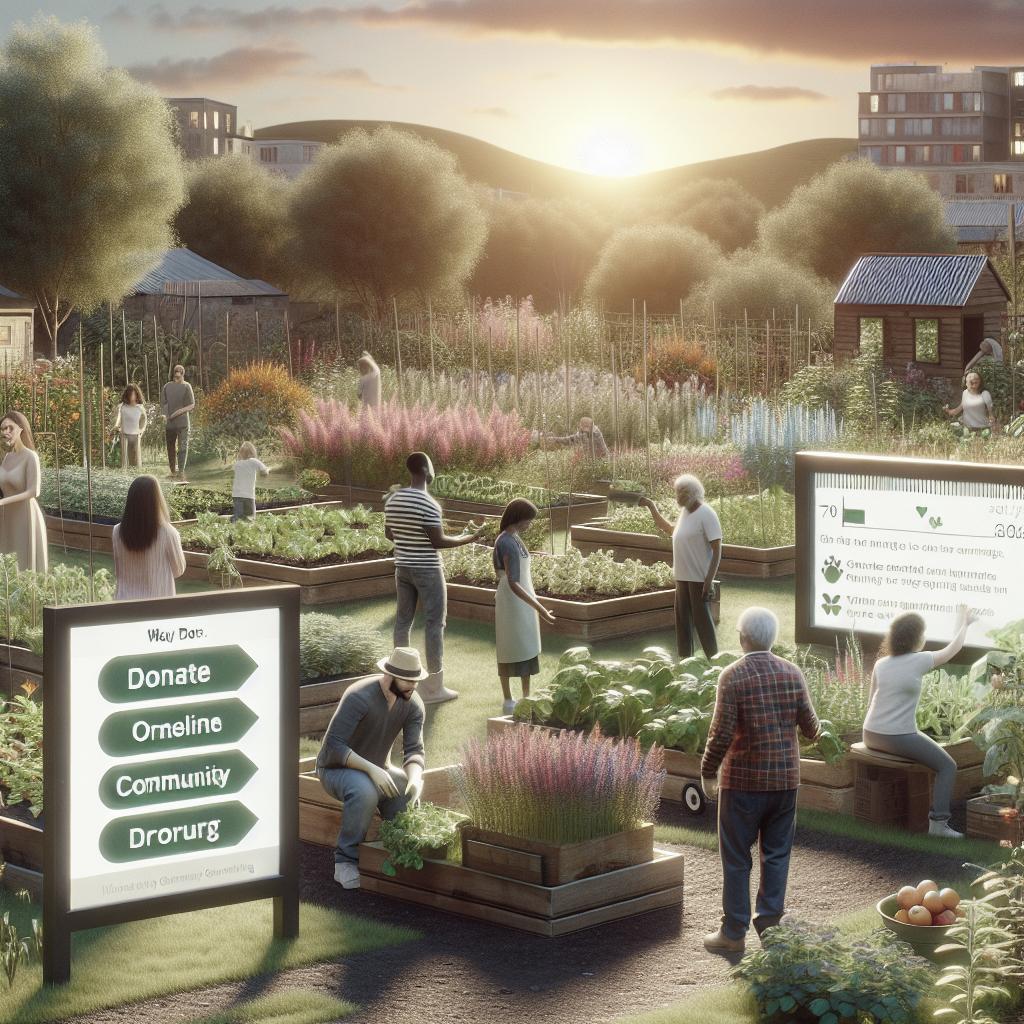How to Plan for Garden Maintenance and Sustainability Creating a sustainable garden involves more than just selecting the right plants. It requires thoughtful planning, understanding local ecosystems, and incorporating practices that maintain and enhance soil health, conserve water, and protect the environment. In this comprehensive guide, we will explore various strategies and practices to ensure your garden is not only beautiful but also sustainable. From selecting resilient plant varieties to using natural pest control and making your own compost, this blog post covers everything you need to know to create and maintain an eco-friendly garden. Let’s delve into these sustainable garden ideas and see how you can transform your outdoor space into a thriving, self-sufficient ecosystem.
Sustainable garden ideas
Sustainable gardening involves creating a harmonious and healthy environment. This encompasses choosing the right plants, improving soil health, conserving water, and encouraging biodiversity. Let’s explore practical and innovative ideas to get you started.
1. Plant successional blooms
Successional planting ensures your garden has flowers blooming at different times throughout the year. This not only provides continuous visual interest but also supports pollinators like bees and butterflies throughout their active seasons. To achieve this, select plants with staggered bloom times, such as early spring bulbs, summer perennials, and late-blooming annuals. In addition to sustaining pollinators, successional blooms help maintain soil health by reducing the risk of monoculture-related diseases. By diversifying your plant selection and ensuring different root structures, you can reduce soil erosion and improve nutrient distribution.
2. Use companion planting
Companion planting involves placing different types of plants together to benefit each other. For example, planting marigolds with tomatoes can deter pests, while beans can fix nitrogen in the soil, aiding the growth of nearby plants. This symbiotic relationship reduces the need for chemical fertilizers and pesticides. Furthermore, companion planting can improve crop yields and promote a balanced ecosystem, attracting beneficial insects that prey on harmful pests. This natural pest control method supports a healthy and productive garden without the use of harmful chemicals.
3. Cover crops with protective nets
Using protective nets over your crops helps shield them from pests, birds, and extreme weather conditions. Covering crops can extend your growing season by protecting delicate plants from frost and excessive sun. Lightweight and breathable nets are ideal as they allow sunlight and rain to reach the plants while keeping pests at bay. This method is particularly beneficial for high-value crops or those prone to pest damage. In addition to protecting your plants, nets can reduce the need for chemical pesticides, supporting a healthier garden ecosystem.
4. Keep an eye on the weather
Monitoring weather patterns is crucial for successful garden maintenance. By staying informed about upcoming weather changes, you can take preventive measures to protect your plants from extreme conditions, such as frosts, storms, or heatwaves. Using weather apps or subscribing to local weather alerts can help you stay prepared. Weather awareness also helps in scheduling watering and fertilizing, ensuring plants receive optimal care based on current conditions. Adjusting your garden practices according to weather patterns can improve plant health and reduce unnecessary resource use.
5. Choose resilient varieties of plants
Opt for plant varieties known for their resilience to local climate and soil conditions. Hardy plants require less maintenance, water, and pesticides, making them a sustainable choice. Research native and drought-tolerant species that thrive in your region to minimize garden upkeep. Resilient plants are less susceptible to diseases and pests, reducing the need for chemical treatments. They also often require less water, which is crucial for sustainable gardening, especially in areas with water scarcity.
6. Improve soil health
Healthy soil is the foundation of a sustainable garden. Regularly add organic matter, like compost or aged manure, to improve soil structure and nutrient content. Mulching with organic materials helps retain moisture, suppress weeds, and protect soil from erosion. Testing your soil periodically for pH and nutrient levels ensures you provide the right amendments to keep it fertile. Healthy soil supports robust plant growth and reduces the need for synthetic fertilizers, promoting an eco-friendly garden.
7. Choose native plants
Native plants are adapted to local conditions and require less water, fertilizer, and pest control. They provide essential habitat and food sources for native wildlife, promoting biodiversity. By incorporating a variety of native species, you create a self-sustaining garden that supports local ecosystems. Native plants are often more resilient to local pests and diseases, reducing the need for chemical interventions. They also contribute to soil health and stability, supporting overall garden sustainability.
8. Leave the lawn to grow
Allowing part or all of your lawn to grow naturally encourages wildflowers and grasses to flourish. This creates a habitat for insects, birds, and other wildlife, enhancing biodiversity. A wild lawn requires less mowing, saving on fuel and reducing emissions. In addition, longer grass improves soil health by retaining moisture and preventing erosion. Letting your lawn grow naturally also reduces the need for fertilizers and pesticides, supporting a more sustainable garden environment.
9. Try permaculture gardening to improve eco-credentials
Permaculture gardening focuses on creating a self-sustaining ecosystem by mimicking natural processes. This involves using companion planting, recycling organic waste, and conserving water through methods like rainwater harvesting. Permaculture gardens are designed to be low-maintenance and resilient. By integrating permaculture principles, you can create a garden that is not only sustainable but also productive. This approach reduces reliance on external resources and promotes a balanced, healthy garden ecosystem.
10. Plant a dry garden to save water
Dry gardens are designed to thrive with minimal water. By selecting drought-tolerant plants and incorporating gravel or mulch to retain moisture, dry gardens require less irrigation. This is particularly beneficial in regions with water shortages or restrictions. Dry gardening reduces water use, supports soil health, and lowers maintenance requirements. It also creates a unique and aesthetically pleasing garden space that stands out from traditional lush green landscapes.
11. Plant nectar-rich flowers to attract pollinators
Pollinators like bees, butterflies, and hummingbirds are essential for the reproduction of many plants. Planting nectar-rich flowers supports these vital creatures and ensures your garden flourishes. Choose a variety of blooms that offer nectar throughout the growing season. Nectar-rich flowers not only attract pollinators but also add color and beauty to your garden. Supporting pollinator populations helps ensure the health and productivity of your garden, promoting a balanced ecosystem.
12. Use natural pest control
Natural pest control methods, such as introducing beneficial insects or using organic sprays, minimize harm to the environment. Ladybugs, for example, prey on aphids, while neem oil can deter various pests without damaging plants. Implementing natural pest control reduces the need for chemical pesticides, supporting a healthier garden ecosystem. This approach protects beneficial insects and pollinators while keeping pest populations in check.
13. Collect rainwater
Harvesting rainwater is an excellent way to conserve water and reduce your garden’s reliance on municipal supplies. Simple systems, like rain barrels connected to downspouts, can capture and store rainwater for later use in irrigation. Rainwater is free of chemicals often found in tap water, making it ideal for plants. Collecting rainwater supports water conservation and can lower your utility bills, promoting a sustainable garden.
14. Feed the birds
Providing bird feeders and baths encourages avian visitors, which can help control insect populations naturally. Birds also contribute to seed dispersal and pollination, supporting garden biodiversity. Creating a welcoming environment for birds enhances your garden’s ecosystem and can reduce the need for chemical pest control. Birdsong and activity also add to the enjoyment and aesthetic appeal of your outdoor space.
15. Grow your own vegetables
Growing your own vegetables reduces your carbon footprint by minimizing the need for transportation and packaging. Homegrown produce is fresher and often more nutritious than store-bought options. Start with easy-to-grow vegetables like tomatoes, lettuce, and herbs. Additionally, vegetable gardening can be therapeutic and rewarding, offering a sense of accomplishment. Incorporating vegetable beds into your garden promotes sustainability and provides a source of healthy, organic food.
16. Plant more trees
Trees provide numerous environmental benefits, including carbon sequestration, habitat for wildlife, and shade that reduces energy use in homes. Planting trees contributes to air and soil quality, making your garden more sustainable. Select native and drought-tolerant tree species to ensure they thrive with minimal maintenance. Trees also add structure and beauty to your garden, enhancing its overall aesthetic appeal.
17. Filter pollution with plants and trees
Certain plants and trees can help filter air and water pollution. For example, evergreens can trap dust particles, while willows can remove pollutants from water through their root systems. Integrating these plants into your garden supports a cleaner environment. By selecting plants that filter pollutants, you contribute to both local and global environmental health. This approach promotes sustainability and improves the quality of life for both people and wildlife.
18. Plant hedges for boundaries
Hedges create natural boundaries and provide privacy, windbreaks, and habitats for wildlife. Choosing native hedging plants supports local biodiversity and can reduce the need for artificial fencing. Hedges also contribute to soil stability and reduce erosion. By incorporating hedges into your garden design, you enhance its sustainability and aesthetic appeal.
19. Upcycle garden furniture
Upcycling involves repurposing old items into new, functional garden furniture. This reduces waste and the demand for new materials. For example, wooden pallets can be transformed into stylish benches or planters. Using upcycled furniture adds unique character to your garden and promotes a sustainable lifestyle. It also offers a creative and cost-effective way to furnish your outdoor space.
20. Create animal shelters
Building shelters for wildlife, such as birdhouses or insect hotels, supports biodiversity. These structures provide safe havens for beneficial creatures, encouraging a balanced ecosystem in your garden. Animal shelters can be made from natural or recycled materials, further promoting sustainability. By providing habitats for wildlife, you enhance your garden’s ecological health and foster a connection with nature.
21. Make your own compost
Composting transforms organic waste into nutrient-rich soil amendments. By composting kitchen scraps, garden clippings, and other organic materials, you reduce landfill waste and improve soil health. Compost enriches the soil, supports healthy plant growth, and reduces the need for synthetic fertilizers. It’s an essential practice for sustainable gardening that also helps reduce greenhouse gas emissions associated with waste decomposition in landfills.
22. Add a water feature
Water features like ponds or rain gardens enhance garden biodiversity by providing habitat for aquatic plants and animals. They also support water conservation by capturing and filtering rainwater. A well-designed water feature can become a focal point of your garden, adding beauty and tranquility. Ensure your water feature is safe for wildlife and low-maintenance to maximize its sustainability benefits.
23. Create natural flood defences
Natural flood defenses, such as swales and rain gardens, manage water runoff and reduce the risk of flooding. These features trap and absorb excess water, protecting your garden and surrounding areas. Incorporating natural flood defenses supports water conservation and soil health. They also enhance garden aesthetics and provide habitat for wildlife, promoting overall sustainability.
24. Adapt and replace
Adapting and replacing plants that struggle with your garden’s conditions can improve sustainability. Choose species that thrive in your climate and soil to reduce maintenance and resource use. Regularly assess your garden and be open to making changes. Adapting and replacing ensures your garden remains resilient and sustainable, maximally supporting local ecosystems.
25. Future-proof your planting
Future-proofing involves selecting plants that can withstand changing climate conditions. Opt for drought-tolerant, heat-resistant, and resilient species to ensure your garden thrives in the long term. Planning for the future helps mitigate the impacts of climate change on your garden. It ensures that your outdoor space remains sustainable and productive for years to come.
26. Look at what grows locally
Observing what grows naturally in your area can inform your plant choices. Local plants are often well-suited to the climate and soil, requiring less maintenance and resources. By choosing locally adapted species, you support local biodiversity and create a more sustainable garden. This approach also reduces the risk of introducing invasive species that could harm native ecosystems.
27. Don’t cut down
Avoiding unnecessary cutting or trimming of trees and shrubs supports wildlife habitats and plant health. Over-pruning can harm plants and reduce their ecological benefits. Leaving plants to grow naturally enhances garden aesthetics and promotes a healthy ecosystem. It also reduces maintenance efforts, supporting sustainable gardening practices.
28. Focus on foliage, form, and texture
Incorporating a variety of foliage, forms, and textures adds visual interest and supports biodiversity. Different plant structures provide habitats for various insects and animals, contributing to a balanced ecosystem. Focusing on foliage, form, and texture reduces reliance on flowers alone for garden beauty. This approach promotes sustainable gardening by fostering a diverse and resilient plant community.
What is a sustainable garden?
A sustainable garden minimizes environmental impact and supports a balanced ecosystem. This involves using eco-friendly practices, such as water conservation, organic gardening, and habitat creation. Sustainable gardens prioritize local and resilient plants, reduce chemical use, and promote biodiversity. Creating a sustainable garden requires thoughtful planning and commitment to environmental stewardship. It’s about working with nature rather than against it to create a harmonious and self-sufficient outdoor space.
What is sustainable planting?
Sustainable planting focuses on choosing plants that thrive with minimal intervention and support ecological balance. This includes native species, drought-tolerant plants, and those that attract pollinators. Sustainable planting reduces resource use and promotes a healthy garden environment. By selecting plants that are well-suited to your local conditions, you can create a garden that requires less water, fertilizer, and pest control. Sustainable planting supports long-term garden health and contributes to environmental conservation.
How can I make my garden sustainable?
To make your garden sustainable, start by assessing your current practices and identifying areas for improvement. Implement water-saving techniques like rainwater harvesting and mulching. Choose native and resilient plants, and incorporate organic gardening methods. Create habitats for wildlife and reduce chemical use. Regularly review and adapt your gardening practices to ensure they align with sustainability goals. Engaging with local gardening communities and resources can provide valuable insights and support your efforts to create an eco-friendly garden.
Sign up to the Homes & Gardens newsletter
Receive the latest tips and trends on sustainable gardening by signing up for the Homes & Gardens newsletter. Stay informed with expert advice, eco-friendly garden ideas, and inspiration for creating a beautiful and sustainable outdoor space.
| Lesson | Description |
|---|---|
| Sustainable garden ideas | Strategies to create an eco-friendly garden. |
| Plant successional blooms | Continuous blooms and soil health benefits. |
| Use companion planting | Synergistic plant relationships to reduce pests and improve yield. |
| Cover crops with protective nets | Protect plants from pests and extreme weather. |
| Keep an eye on the weather | Adapt garden care to changing weather conditions. |
| Choose resilient varieties of plants | Opt for plants that thrive in local conditions. |
| Improve soil health | Enhance soil with organic matter and mulching. |
| Choose native plants | Support local ecosystems and reduce maintenance. |
| Leave the lawn to grow | Encourage biodiversity and reduce mowing. |
| Try permaculture gardening | Create a self-sustaining garden ecosystem. |
| Plant a dry garden | Implement drought-tolerant plants to save water. |
| Plant nectar-rich flowers | Attract pollinators for a thriving garden. |
| Use natural pest control | Minimize chemical use with beneficial insects and organic sprays. |
| Collect rainwater | Harvest rain for eco-friendly irrigation. |
| Feed the birds | Support avian wildlife for natural pest control and biodiversity. |
| Grow your own vegetables | Reduce carbon footprint with homegrown produce. |
| Plant more trees | Enhance environmental benefits and garden structure. |
| Filter pollution with plants and trees | Improve air and water quality with specific plants. |
| Plant hedges for boundaries | Create natural fences and support local wildlife. |
| Upcycle garden furniture | Reduce waste with creative and sustainable furniture solutions. |
| Create animal shelters | Support biodiversity with birdhouses and insect hotels. |
| Make your own compost | Recycle organic waste for nutrient-rich soil amendment. |
| Add a water feature | Promote biodiversity and water conservation. |
| Create natural flood defenses | Manage water runoff with eco-friendly solutions. |
| Adapt and replace | Choose plants that thrive in your garden conditions. |
| Future-proof your planting | Choose resilient species for long-term sustainability. |
| Look at what grows locally | Learn from native plant success to inform choices. |
| Don’t cut down | Maintain natural growth for plant health and habitat. |


